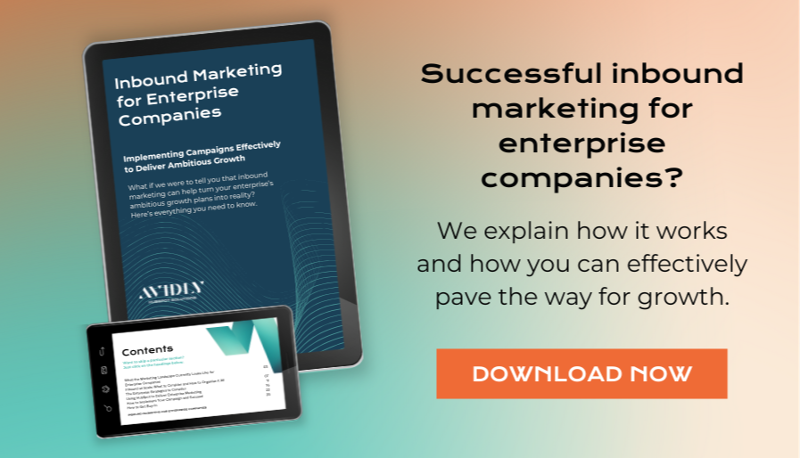The HubSpot Flywheel revolves around customers feeding growth. To turn strangers and prospects into...
“Watch what I do, not what I say.” If this was about me, you’d watch me spend too much money on footwear and then listen to me telling you why they’re great purchases. But this isn’t about me — it’s about Gary Vaynerchuk (aka Gary Vee) and how he actually does marketing.
Side note: this man has plenty of quotes online which are hard to keep track of, but this one seems to resonate the most. Why? Well, he talks a lot.
Not that it’s a bad thing. After all, he’s a self-made millionaire whose net worth is expected to reach $200 million fairly soon. He’s the CEO of a full-service digital agency, VaynerMedia. He’s the co-founder of VaynerSports which is an athlete representation agency. He’s a best-selling author. He successfully predicted consumer behaviour and invested big in the likes of Facebook, Snapchat, Twitter, Uber, Medium, Tumblr and TikTok long before they became the global phenomena they are today. And that’s just naming a few I could find on his LinkedIn profile.
So why would someone who’s this successful tell people not to listen to what he has to say? He has plenty of videos on his YouTube channel, his podcast, his keynotes and events, meaning there are plenty of channels where people can listen to his expertise. When he breaks it down, though, it’s quite simple. By following what he does, paying attention and actually applying the learnings, you’ll gain far more value.
So if he tells us to produce content and we listen, we’d go and create content. But what he’s telling us to do is look at all of his channels to see the type of content he’s creating, its themes, when he posts it all, where it’s published, the time it goes out and much more. That’s where the true value is.
So, when Rikki sent me on the mission to find out what Gary Vee actually does, I channelled my inner Joe Goldberg/Will Bettelheim/Jonathan Moore to see if Gary practices what he preaches.
Here’s what I found.
- Why you need to sit up and pay attention
- The volume-based content strategy
- Gary Vee’s social media work revolves around attention
- What Gary Vee and his brands do on social media
- What Gary Vee is doing that other marketers aren’t
Why you need to sit up and pay attention
I get it. Gary Vee is a divisive character and isn’t everyone’s cup of tea, so I don’t blame you for sitting there like 🙄. This isn’t a blog bashing him and his methods and it’s definitely not a biased piece fighting his corner. However, there’s no denying he’s a huge figure many just can’t escape from. He’s everywhere, on every channel and has legions of followers who live and die by his methods.
So if so many people see him as the best in the game, it’s hard not to look at what he’s doing. He knows what works and what doesn’t so whatever he’s doing right now, the likelihood is marketers will be doing it next year. If he’s so far ahead of the curve, look at what he’s doing now so you get ahead of your competition.
He’s taken advantage of pretty much every area of digital marketing early on — even the areas where businesses struggle today.
- Google Ads and email marketing: Using email marketing and Google Ads, Gary grew his family business from $3 million to $60 million per year in just five years. Open rates (90%) and the cost-per-click ($0.05) were massively underpriced — and he enjoyed the rewards.
- Video marketing: YouTube was on the rise in 2006 and Gary created the show Wine Library TV. Within one year, the channel catapulted him to national fame as he appeared on TV shows and became a huge name in marketing.
- Social media marketing: As an investor, Gary was not only a big advocate of Twitter but adopted it early on as he quickly grew his following to 850,000 back in 2009.
He built his and his brand’s presence. He became well-known. He adopted these methods and tools early on and the rest now follow. Regardless of how he’s perceived, it’s a good idea to watch what someone who’s been there and done it to absorb as much as you can from them.
The volume-based content strategy
With someone who’s as busy as Gary with his finger in more pies than I can count, it’d be crazy to assume he’s sending out a lot of content with the lack of time he’d have. You don’t need an influencer to tell you that you need to produce content regularly but if we’re watching what Gary’s doing, he’s actually producing almost 100 pieces of content per day.
Well, his team of 20 people are helping create the majority of it, but he’s sending out a lot of content either way. Now, before you rope in your entire content team and assign them all 20 pieces of content to write each day, understand that every piece of content isn’t brand new.
Quick answer: He creates a big piece of content and then his team creates smaller content from that. These clips, images, quotes and everything in between are then shared with the different channels under the Gary Vee umbrella. For a more in-depth look at the strategy, keep reading.
He creates a main content ‘pillar’ — then repurposes it into ‘micro-content’
In fact, Gary uses a reverse content pyramid where one piece of content (what we call a content pillar) is repurposed into other pieces of content. It’s designed to over-index the platforms they’re distributed to. In his case, it tends to be his daily vlog, a keynote, a podcast episode or even a Q&A session. His team then uses that main pillar to create short-form content pieces, anything from articles and quotes to memes and GIFs.
One single theme could open the doors for so many more pieces of content to distribute. All without investing more time, energy and resources into creating brand-new content daily.
For that micro-content, his team looks through the pillar content and picks out bits they believe will resonate with their audience and create short-form videos, articles, images — anything.
He then distributes both the pillar and micro-content on different platforms on two different occasions. The first time, the focus is on driving viewership to the pillar content. Here’s a rough example of where his content goes and in this instance, let’s assume the pillar content is his Ask Gary Vee show.
- Pillar content: The main content piece gets published on the likes of Facebook, a podcasting hosting website and YouTube.
- Micro-content and stories: Snippets from the pillar content are turned into either a smaller content piece or into stories. This gets shared on LinkedIn, Instagram, Facebook, Snapchat and Twitter.
- Articles: Follow-up articles taken from the pillar content get published on Quora, Medium, LinkedIn, his website and through email marketing.
Knowing what to produce and where to distribute is only half the battle. The other is when to post all of this content. You might already have your schedule but if we dive a little deeper into what Gary does, his schedule isn’t that farfetched. There doesn’t seem to be an elaborate social media calendar where every piece of content is meticulously timed to go out to the world.
|
Platforms |
Post times |
|
|
12:00 PM EST |
|
Podcast |
12:00 PM EST |
|
YouTube |
12:00 PM EST |
|
IGTV |
12:01 PM EST |
|
|
12:01 PM EST |
|
|
12:01 PM EST |
|
Snapchat |
12:01 PM EST |
|
|
12:01 PM EST |
As the table above shows, Gary Vee and his team don’t keep hold of micro-content and release it when they’re short of ideas (not like they ever will be with so much content going out). Instead, they hit publish on other platforms literally one minute after the main content pillar is live.
In a typical content strategy, that could be the end of it. The main piece of content is live, a handful of smaller content pieces have been created from it and you move on to the next one. That’s not what Gary does for his brand. The next stage revolves around listening to his audience to find out what has resonated with them so far.
If it’s not something you currently do, it’s worth trying. If there’s a specific section of your in-depth blog your readers love or a certain part of your video people find the most insightful, hone in on that so you know what to focus on. In terms of what Gary does, a quick browse of many of his YouTube videos will show you a simple yet effective tactic. To engage with his audience more, he tells viewers to comment with a timestamp to a section of the video they enjoyed.
He does that so he can find the insights he needs, allowing him to make more content his audience wants to see. Again, while the majority might push content out and move on to a new piece, Gary’s strategy continues. Once the content is live and he gains insights, he creates even more. This is where community-driven micro-content production begins.
Once he creates more micro-content around the topic that hooked his audience, he starts distributing again across all his social media platforms to, who he calls, his ‘Vayner Nation’.
One keynote = 33 content pieces: an example of Gary Vee’s content strategy
Ready to see Gary’s method in action? Here’s a breakdown of how he made 33 content pieces from one of his keynotes. For the full analysis of his content strategy so you actually see what he does, click here to jump further down to see his Slideshare.
The main content piece
Back in 2017, Gary gave a keynote (here it is if you were wondering what it was about) which was almost two hours and 30 minutes long. That duration alone should give you a good idea of where this is going. Before the actual keynote, he recorded a short clip to offer viewers some context on what to expect and badged it as a vlog from his successful series, DailyVee.
Video turns to audio
He then extracted that audio and quickly turned it into an audio podcast. That’s something we do at Avidly and if you shoot film, you should too. It opens up more opportunities to get leads. You never know, somebody might stumble across your audio on SoundCloud, Spotify or Apple Podcasts, rather than your YouTube channel.
His team gets to work
Once the content was live, his team grabbed parts of the keynote they thought would be good for driving viewership and downloads back to the pillar content.
Distribution
The pillar content, in this case, his keynote, was then distributed to YouTube, Facebook and his podcast, so he could cover all the relevant channels. The audio podcast was then shared on over 10 audio-focused platforms and did some big numbers. His team then took to Instagram, Facebook, Snapchat and Twitter to distribute the first round of micro-content.
They gain insights…
With the keynote live, his team looked through the comments to gain insights on the aspects that resonated with them.
...and apply them
Then they honed into the specific social media channels. They took the best moments and created more content. Here’s a breakdown of what that looked like:
- Facebook: They created two more videos with four content pieces to share and became new original content as they were edited and presented in a new way with custom titles and copy. This helped gain high viewership, with the lowest getting over 100,000 and the highest racking up over 15 million views.
- Instagram: Those Facebook clips were then repurposed into 60-second versions for Instagram. This got Gary even more high-performing posts (ranging from 700,000+ to 1.7 million and counting) which were reshared multiple times. Again, with minimal effort and no ‘brand new’ content, despite looking like it is.
- Instagram...again: The focus turned to quotes. The best quotes from the top-performing videos were selected to be repurposed into images to post on Instagram and Twitter to amplify reach even more.
- Twitter: The quotes found their way to Twitter once they were repurposed in a format native to the platform. This gave Gary even more ammo to drive viewership back to the pillar content or the audio podcast for extra promotion.
- Aaaand back to Instagram: Gary and his team made sure to take advantage of every feature possible. They took the best 15-second clips and then used Instagram Stories to drive viewers back to the micro-content to increase engagement even more.
- Snapchat: What Gary did on Instagram Stories, he did the exact same again. Only this time, it was repurposed for his Snapchat audience to drive viewership among a new group of people.
- GIFs: Following that, his team created GIFs for people to use when replying on Twitter, Facebook or Instagram Stories.
- Written content: If that wasn’t enough content, his team then picked the best themes from each video and turned them into standalone articles. To each one, he added a few major points to expand on something new which offered new value, despite not being fresh content.
The end result? One keynote turned into over 30 pieces of content, resulting in over 35 million views and counting. Not bad. Check out his full Slideshare below.
We’ve watched what Gary Vee does, so how can you apply his methods to your strategy?
Although Gary’s pillar content seems to be infrequent (more on that in the social media section), it’s clear to see the sheer volume of content he and his team put out. It’s a case of minimal effort, maximum rewards and although it’s nothing groundbreaking nobody has ever thought of before, always creating fresh content isn’t the best way to drive results and increase readership.
Instead, optimising existing content and creating smaller topics around the main theme can boost your results. The volume aspect is something Meghan Keaney Anderson, VP of Marketing at HubSpot, discussed at the LOVE INBOUND 2020 event. It somewhat links to the Gary Vee strategy — he and his team optimises the main content pillar to create smaller, relevant materials.
You can check out the video below to hear what Meghan had to say in more detail.
If creating micro-content, or content in general, is something you don’t do or you’re inconsistent, here’s how you can do it relatively easily by using the same method as Gary Vee.
- Regularly create and publish a main content piece. Whether it’s a podcast, a video documentary, an in-depth article or anything in between, create one regularly. It should offer enough value as a standalone piece but also enough for you to branch out and create smaller content from that.
- Chop it up. If it’s a video, pick out the best bits and create smaller videos for your social media accounts, like Instagram and Facebook. Also, make sure the quality is great and upload it to YouTube.
- Create written content. Either you or your content team can then use that main content piece and create a blog around that topic.
- Produce some snazzy graphics. If you have a designer on hand, great. Create custom graphics to use on your social media channels. They can create templates for you to place the videos, inspirational quotes or even the odd meme or two to encourage social sharing.
At a top level, that’s an easy way to get started using Gary Vee’s strategy. Now, let’s dive a little deeper into the other important part of driving results through content — sharing it on social media.
Gary Vee’s social media work revolves around attention
Imagine it’s my business going up against your business. You’re dominating Facebook, LinkedIn and Instagram to a point where I’m thinking, “S**t, there’s no point in me wasting my money on platforms where my rivals already have a strong grip.”
Instead, I’d realise you’ve neglected Twitter entirely so all my efforts would be invested into that platform.
As valuable as the platform is, that would be a bad move on my part. Really bad.
That’s not to say Twitter isn’t worth investing your resources in. The point is to look at what Gary Vee does and his social media revolves around one thing: attention. That’s what he cares about and you should too.
The net worth of wealthy companies like Facebook, Instagram and Google is based on their ability to capture and monetise attention. The more attention they capture, the higher the company valuation or in simpler terms: more attention equals more money. Check out the graph below. It shows how Facebook captures the most attention per day (almost 1,400 hours) and it shows in their company valuation.
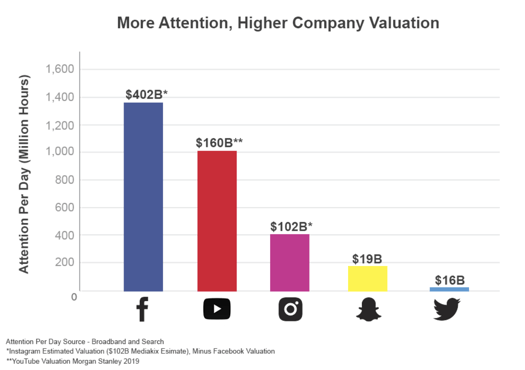
So, if Gary Vee goes heavy on the likes of Facebook and YouTube because that’s where the attention is, then you should too. Even if your competitors are already on those channels, don’t let them have all the fun. They’re sharing on the relevant social media channels for a reason, so think about doing the same. Gary succeeded and still enjoys success to this day because he took the plunge. He adopted the platforms early and negative comments haven’t stopped him.
Another mistake many tend to make is taking a ‘one-and-done’ approach when it comes to pushing content on social media channels. If they upload something and it doesn’t work, they’ll move on to the next one in the hopes of better success. However, what Gary has done is take each platform seriously and this helps him consistently achieve massive audience growth.
He’s done this for over 20 years. He’s figured out where people’s attention is and he puts his focus there. He did email marketing back in 1997, he took advantage of Google AdWords in 2000, he was on the YouTube hype early in 2006, Twitter in 2007, Snapchat and the list goes on.
He hasn’t stopped either. With every tweet, video or written content, he — or anyone else doing the same — can influence the opinions of the people whose attention they own. By owning that attention, he and others who focus on capturing attention can persuade people to buy their products or services.
To this day, Gary Vee uses the concept of capturing and holding attention through social media platforms to grow his personal brand. Here’s a quick look at how he does it through Twitter, and why.
How Gary Vee captures attention to build his brand
Gary Vee was an early adopter of Twitter. Before all the influencers came along that you see today, he was effectively a ‘celebrity’ in his own right by gaining millions of followers. In the early days, Gary used Twitter to help people learn more about wine. So if somebody posted about trying to find a good wine to go with their meal, he’d answer and offer his expertise.
He did this repeatedly and by doing so, his follower count increased. Although it can seem long-winded to respond to everyone, you keep in mind that the responses were public and everyone could see them. So when he answered somebody’s question about wine, his answer could get retweeted by people and reach new audiences who just learnt something new or answered a query they had but hadn’t yet asked.
That’s something you can adopt for your business too. What Gary didn’t do, however, was having his team log on and respond to his followers. Instead, he developed an 18-cent strategy which involved allocating a set number of hours each week to interact with his community and develop a strategy from there.
Take a look at his Twitter at some point today. You’ll notice he still responds to followers, even if it’s just a generic conversation. It offers that 1-1, human connection you can’t really get anywhere else. It doesn’t just stop on his social media accounts either.
Gary has successfully built and continues to build a human connection with people through his podcast. For the hour or two he’s speaking, he can connect deeply with hundreds, thousands or millions of people. He’s in their ear. He’s talking directly to them and has their attention for an extended time. That’s not something you can do with your usual Facebook ad and that’s not something you’d see Gary doing either.
So, as Gary Vee tries to draw attention to himself on a daily basis, what do his social media accounts look like in action? How much is he posting? Is this micro-content going out as frequently as we think?
After reading countless blog posts and hearing his voice in my head 24/7 after watching more videos than I can remember, the next part of my exciting adventure to see what Gary Vee does took me to the deep depths of his brand’s many social media accounts. I fell into an abyss of inspirational quotes, business advice and Gary’s voice repeatedly telling me “I can do it!”
There were a handful of different accounts on several social media platforms to spot the trends. Here’s what I found.
What Gary Vee and his brands do on social media
Any social media platform Gary Vee is on right now, it’s going to be because he knows it works. As I mentioned, he adopts trends early and people who follow him will want to continue to see what else he has going on. Gary also walks the walk when these platforms first hit the spotlight so as a practitioner with a digital agency, he can explain to clients which approach works and which doesn’t.
Let’s break each one down by social media channel to see what his and his brands’ activity looks like.
Instagram is Gary Vee’s strongest platform, for now. Although he predicts we’re past Instagram’s peak, it’s still a valuable platform for him and his brands. Looking at his statistics through Social Blade, Gary’s main Instagram profile sees him publish an average of three posts per day.
Although there’s no real ‘structure’, a quick glance shows you the type of content he posts regularly. Here are some of the most recent examples:
- Short video clip taken from a pillar content piece
- Inspirational quotes
- Screenshots of his tweets
- Memes featuring Gary’s quotes or video clips
- Personal posts, such as collecting trading cards and throwback images
Three a day seems a manageable amount for someone of his following. However, after digging a little deeper I found he does something pretty unique. His main profile is actually translated into different languages. So while he might send out three posts from his Instagram profile in English, that’s three more each in Chinese, Spanish, Polish, Portuguese, French and Arabic.
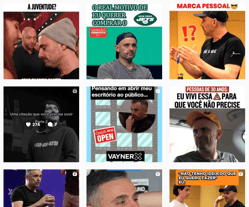
|
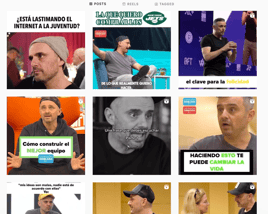
|
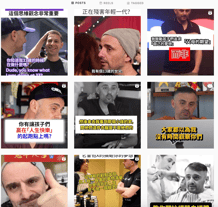
|
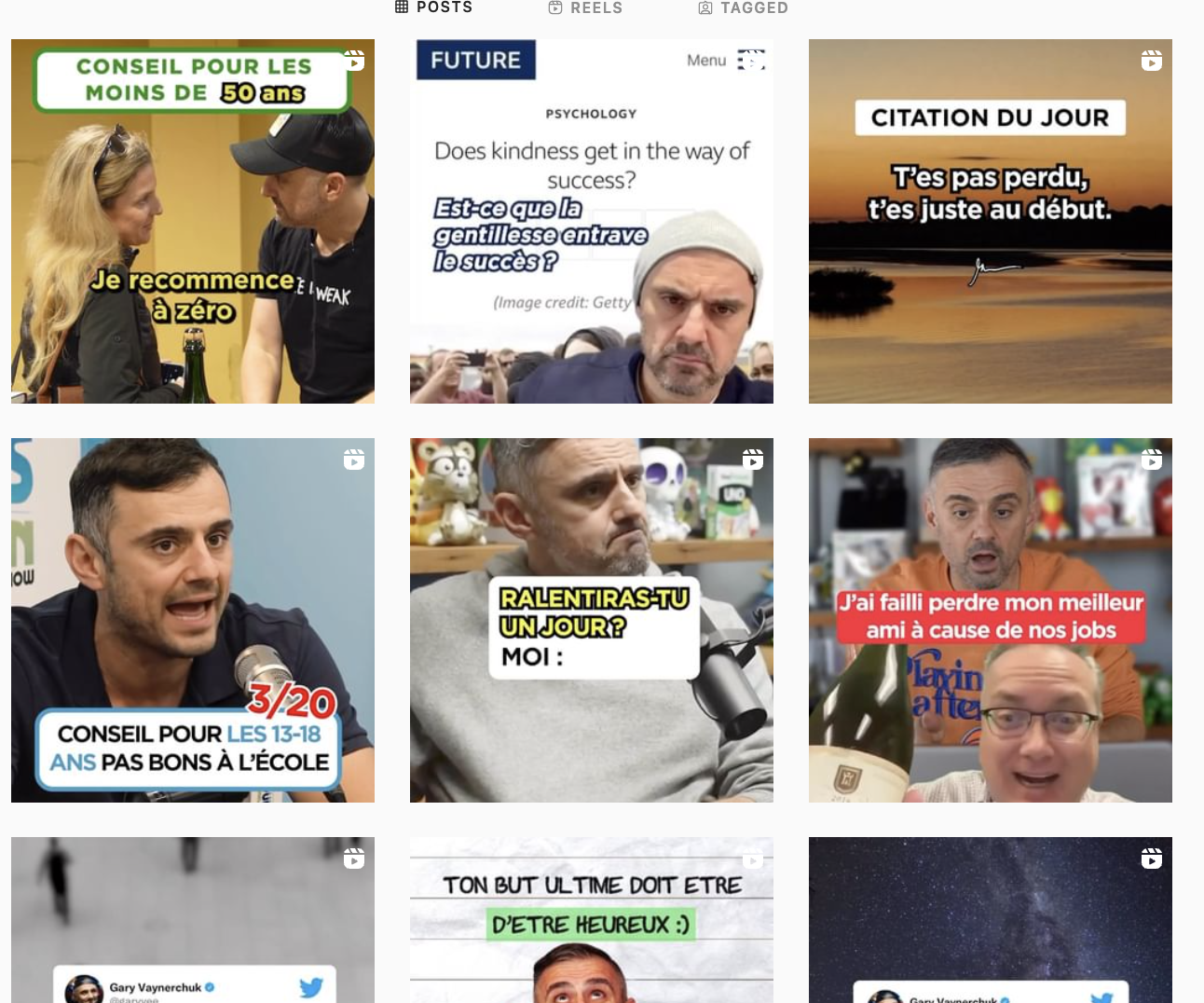
|
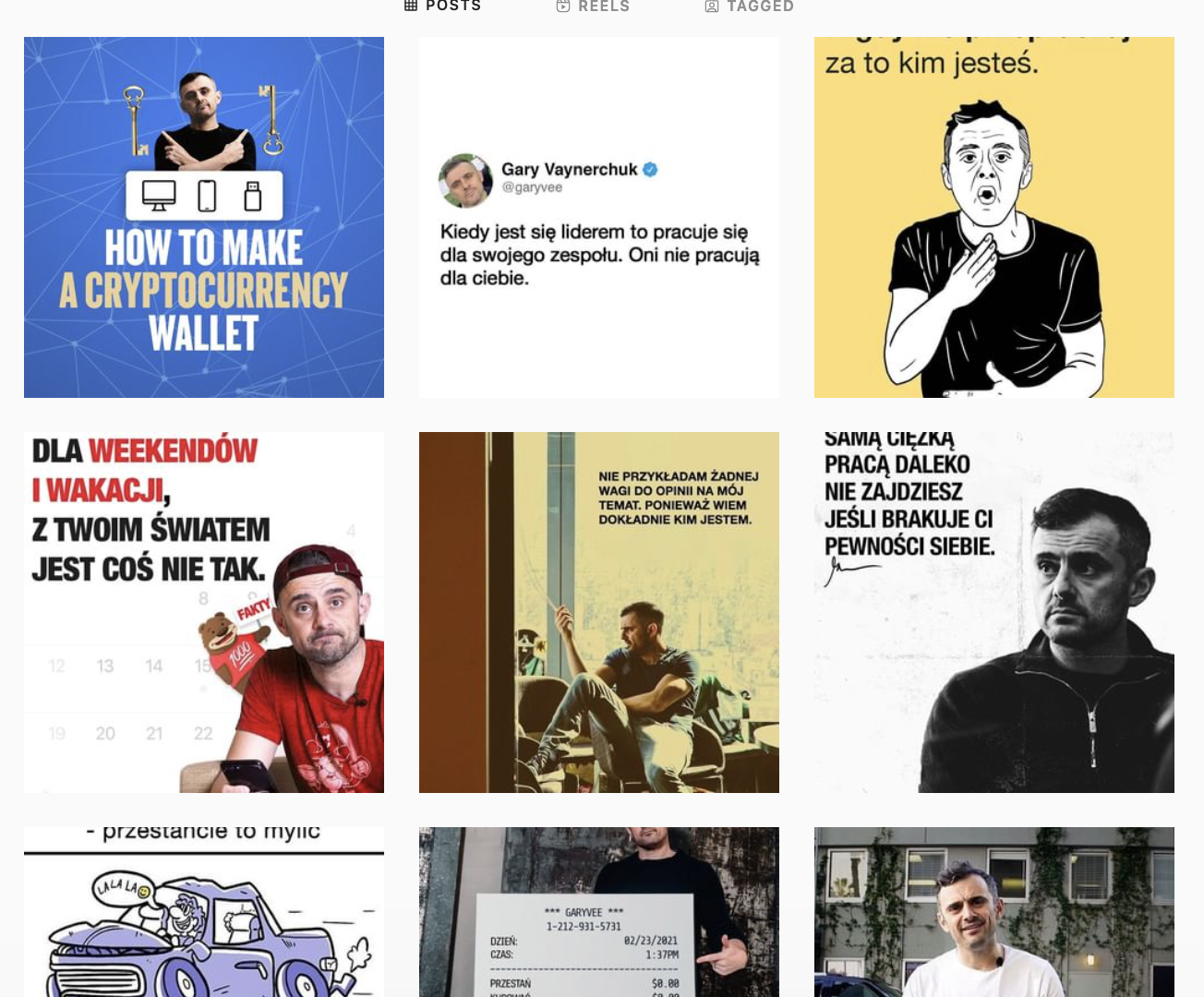
|
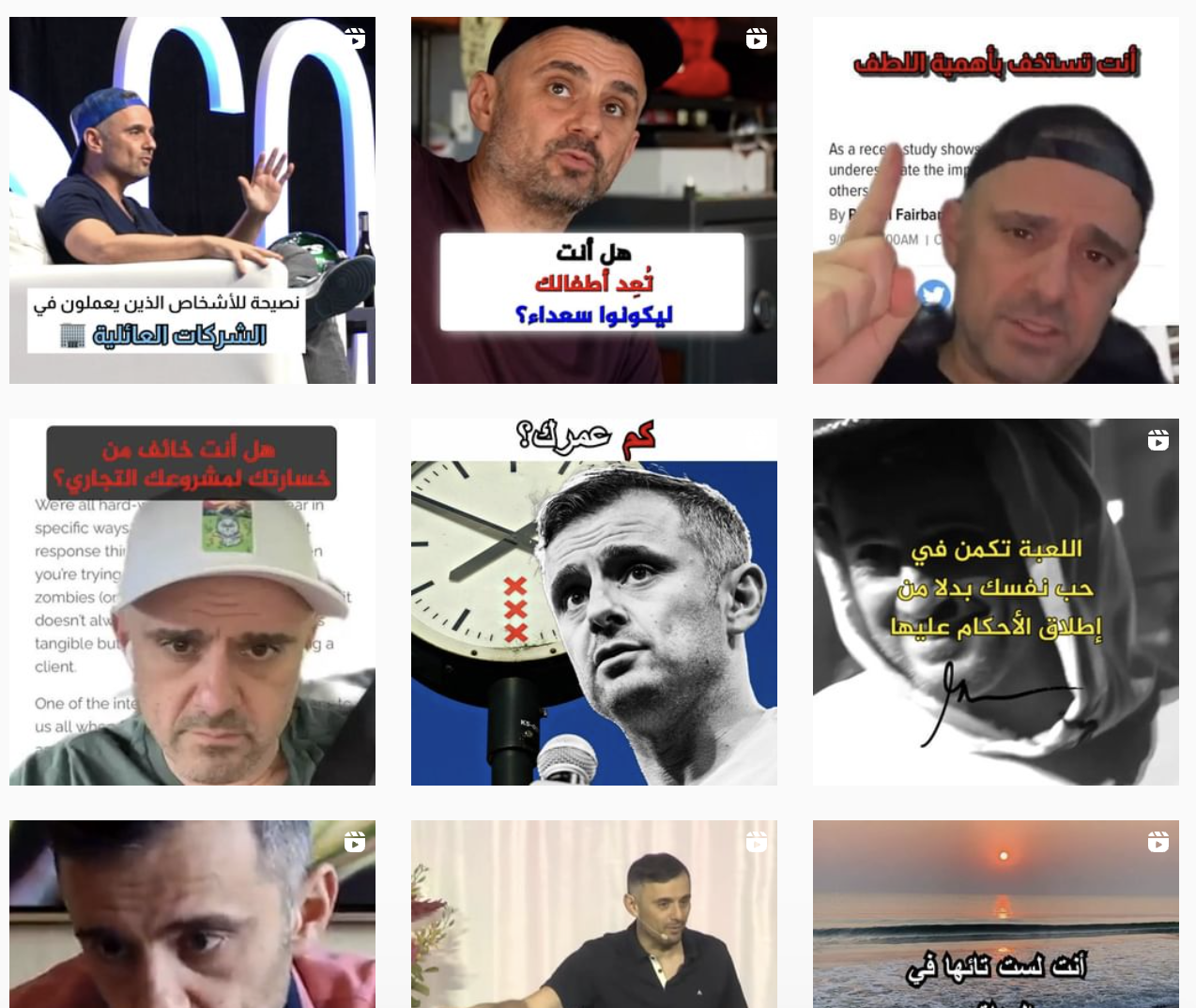
|
Translating it allows him to reach a much wider audience on a global scale. So that main content piece that works well for producing smaller micro-content is great, but repurposing it yet again into different languages allows him to remain a worldwide thought leader.
His other accounts don’t seem to follow suit. The likes of VaynerMedia and VaynerSports tend to post more sporadically on Instagram. You’ll find a mixture of quotes, pictures and videos of Gary, in-the-moment posts such as events and marketing initiatives. Judging the Instagram profiles under the Vaynerchuk umbrella, his personal brand is his strongest by a wide margin.
Facebook is a funny one for Gary and his brands. The attention is there but the core audience is much older at around 40-to-90-year-olds. If he focused on what they cared about and produced content tailored to them, he’s confident he’d do even better on the platform.
At the minute, his main profile still pushes out content but the majority isn’t original. Like Instagram, he averages around three to four posts a day and the content you see is pretty much identical to what you’d see on his Instagram feed. However, both VaynerSports and VaynerMedia are a lot more sporadic when it comes to pushing content out on Facebook compared to Gary’s personal account.
Again, his Facebook feed features a mix of videos, inspirational quotes, graphics and quotes from his previous keynotes. He also ensures to encourage interaction through each post which tends to rack up the comments from his followers.
Twitter tends to be the place where Gary interacts the most (considering he’s tweeted almost 190,000 times). What’s great about what he does on Twitter is he comes across as human — a lot more than other entrepreneurs on the platform which is amazing to see. In fact, when I was doing his research, he interacted with his followers so much that I went from reading tweets on creative thinking to how much basketball trading cards sell for.
That alone is a great incentive for people wanting to interact with him, knowing there’s a high chance he’ll respond with a comment or offer his expertise. His Twitter is also varied when it comes to the type of content he pushes out.
- Written tweets, retweets and responses
- Retweeting positive feedback
- Videos and audio clips
- Written notes from his smartphone
- Inspirational quotes
- Advice
The VaynerMedia Twitter account is also quite active after tweeting over 11,000 times in total. VaynerMedia tends to retweet most of what Gary posts on his Twitter account but it’s a lot more marketing and event-focused, which makes sense. Although, there’s another Twitter account which is worth keeping an eye on and is a smart move from Gary and his team.
@GaryVeeTV is a channel dedicated to the best moments and quotes from Gary and the account was only created in April 2020. It’s another channel for Gary to get his message out there to followers who may not necessarily be following him at the time but could spot something that’s either retweeted or replied to by a connection they know.
At a quick glance, there’s plenty of content being tweeted daily. On June 15 alone there were 28 different clips posted ranging from a few seconds to minute-long snippets taken from pillar content or keynotes.
Again, it’s another effortless way to push out content without necessarily creating anything brand new.
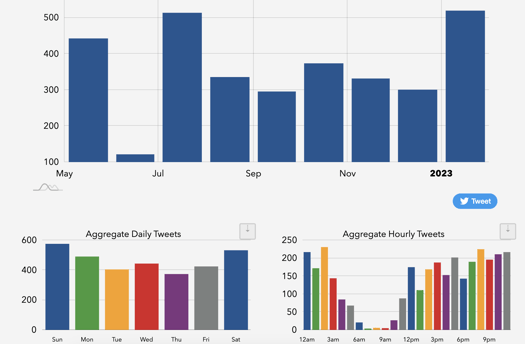
Snapchat
Although it can work wonders for some, it’s not a top priority by the looks of it. Who knows, Snapchat might release one amazing update down the line and once again it’s all the rage. Gary does post daily on it but it doesn’t seem like he has the strongest following on this platform which is stopping him from going all out as he does on Instagram, for example.
Perhaps the difference is that Snapchat comes across as a personal, one-to-one platform, yet Gary’s team helps him manage it rather than doing it on his own like his Twitter account. Although not entirely dead, it’s probably fairer to judge him on his Snapchat activity when the community takes off again.
Then again, he did admit to making a mistake when he criticised Snapchat’s ‘Stories’ feature many years ago.
TikTok
Remember when TikTok was still called musical.ly? Yeah, that’s when Gary Vee started using the platform after realising the potential it had. He even had two of the biggest influencers on his podcast before the rebrand but it wasn’t until 2018 that he started to become serious about the platform.
On TikTok, Gary puts out content anywhere from three to five times a day to his 3.3 million followers. Just like we’re paying attention to what he’s doing, he too pays attention to what the influencers are up to, which videos get the most views, the trends at the time and what can go viral.
Not all of his content is the same either. Around 80% of it is post-production so his team looks at the content he films all day and adds things like stickers, overlays and words to help it stand out a little more on the platform. The rest of his content on TikTok relates to what’s trending, so it’s not just one-dimensional. He and his team look at the challenges and memes that go down well, then create content that revolves around these themes.
Part of the reason why Gary posts more than one on TikTok is because of how seemingly random the algorithm is. You can see in his feed that some might only get hundreds of views but there’s one which manages to gain traction and has millions of people watching it. He also analyses behaviour to see what people are interacting with and consuming things like comments and trends.
The vitality of TikTok is genuine, so it’s worth investing time in looking around and taking the platform seriously.
LinkedIn is a platform Gary Vee says businesses need to start taking advantage of. Why? It’s now (sort of) like Facebook as it’s effectively become a content platform. Years ago, it would’ve all been business talk but now, you’ll see more personal posts like holidays, achievements, relaxing at home after work or anything in between.
Someone like Gary has plenty of followers and connections, so people in their thousands are going to see his content and comment on his posts. LinkedIn allows you to finally be a little more human but hold back on the silliness you wouldn’t want your boss, colleagues or potential employers to see, so it’s a nice balance.
Gary is also quite active on LinkedIn. He isn’t posting with the same frequency as he does on Instagram because the content is slightly different. In one day, he could promote a blog, share a screenshot of a tweet or drop a one-line inspirational quote to help motivate someone.
Just scroll through, paying attention to how many posts he publishes a day (around three) and how many people interact with each one.
If we go back to the quote and focus on the ‘watch what I do’ part, there’s one key takeaway from me and it’s something he’s discussed in many videos. Gary gets a load of criticism to match the praise. But seeing how much content he continues to push on each channel shows that negative comments and eye-rolls don’t stop him and the results speak for themselves. If that’s what’s holding you back from posting content regularly, you could be missing out.
Other content platforms
All of that was just his actual social media channels. He still has other platforms where he pushes content out regularly. Here’s a look at each of them.
The Gary Vaynerchuk blog
His blog doesn't feature anything personal you’d find on platforms like Instagram and Twitter. It’s where readers want to come for thought leadership articles, expertise and his opinions on some of the biggest talking points.
As you’d expect, some blog posts are based on a main content pillar, but you wouldn’t be able to tell if this was your first interaction or the first blog you came across because parts of them are full of fresh content.
He doesn’t post daily as a blog could come out several times per month. That does make sense as there’s only so much written content you can create from one pillar as you’d quickly run out unless you have other big content pieces to crib from.
What I’ve noticed he’s pretty good at is hopping on the latest big talking point and doing a fantastic job of getting his opinions across. Two latest examples include the recent Twitter audio rollout and also Joe Rogan’s massive Spotify deal, showing he remains aware of what’s happening around him.
On a side note, what’s also noticeable is each image for every blog post is unique. There’s some customisation aspect whereas a lot of companies tend to go with stock photos we’ve seen all over the internet. It’s another nice little touch to help make his work stand out.
Medium
His content on Medium isn’t as consistent as his other channels. Although he does use it as a place to push micro-content, he hasn’t updated it since 2018 which should tell you where he’s put his focus. Short and sweet.
YouTube
Considering most of Gary’s content is video-based, it makes sense for him to have a big presence and following on YouTube. We have his keynotes, advice, original movies, series such as ‘Tea With GaryVee’ and more. The first thing you’ll notice is the thumbnails and how they’re all original. Sure, they have his face plastered all over them but they’re not generic and make you want to click on them.
Then the frequency. Despite posting thousands of videos, he doesn’t send out videos on YouTube daily as he might do on Instagram, for example. The main reason for that is his YouTube content is often the pillar content and everything you see on his social media channels tend to point back to his YouTube content.
Although a video isn’t published every day, he’s had months recently when over 20 videos went out. That was especially the case during April which was a time many were at home in lockdown due to the coronavirus pandemic and consuming online content more than ever.
That should be a huge lesson in itself. You shouldn’t stop marketing and creating content right now and video needs to be a huge part of your strategy.
He has another YouTube account as well, GaryVeeTV. The content doesn’t seem to differ much as the themes, thumbnails and topics tend to crossover into both channels. Although both channels promise new videos every day or weekday, that doesn’t always tend to be the case it seems but with the volume of content he’s putting out daily in general, it doesn’t really matter if he skips a day or two here and there.
Plus, there are still videos being published on his VaynerMedia/VaynerX YouTube channel as well. So he not only plugs the gaps if he misses days but he also reaches wider audiences depending on the channel they’re subscribed to.
Hopefully, this gave an insightful look at what’s happening on his social media accounts and his method of publishing content. So, with Gary Vee at the forefront of the industry and his tactics in mind, what’s he doing right now that many other brands could start doing next year?
What Gary Vee is doing that other marketers aren’t
During my research into what I’m seeing from Gary and what I haven’t seen others do, there were three standout points. One of them is quite straightforward — he tends to interact a lot with comments. The second is he’s all-in on video since the very beginning while the majority of marketers are still hesitant on making it a part of their strategy.
The third is a little more unconventional as he’s turned to SMS to send text messages to people which is more personal thanks to the one-on-one interaction.
Interacts with comments
I don’t think I’ve seen a marketer who emphasises interacting with comments and people as much as Gary does. Replying to tweets, in his YouTube comments, on his Instagram — everywhere. He’s admitted that he’s trying to be even more thoughtful with comments on LinkedIn and YouTube, yet is determined to reply to more followers every day on all platforms.
That’s an underrated trait. He’s human and he shows that in his comments. It’s easy to post a picture, a LinkedIn article or a tweet and neglect it. Even if he didn’t respond, he’s guaranteed to do numbers. It’s also what many marketers might do right now — simply push out a piece of content and then focus on the next thing, rather than taking the time to interact with people.
Video content
Although what Gary is doing via video isn’t groundbreaking now, the fact he’s still doing it in 2020 suggests it’s a strategy many need to adopt. When we look at the pillar content he pushes out and the micro-content created from that, the majority all comes from a video, be it a keynote or a Q&A. Everything he does revolves around video because he knows that’s what people want to see.
Here are some stats to prove why he does it and why you need to take video seriously as part of your strategy:
- More than 50% of customers want to see videos from their favourite brands
- Six out of 10 people would rather watch online videos than television
- Mobile video consumption rises by 100% every year
- Viewers retain 95% of a message when they watch it in video form, compared to 10% when reading it in text format
- Videos attract 300% more traffic and can help nurture leads
And that’s just scratching the surface. Imagine the statistics when you take into account how popular YouTube is, how many people use mobile devices, how much video content is consumed and how people love watching videos on social media platforms. People want to watch videos and it’s why Gary’s content revolves around them.
He breaks video down into a bunch of formats too. While the themes remain the same, you’ll see a load of advice, inspiration, behind-the-scenes footage, vlogs and one-to-one interactions which helps to build trust.
He knows the trends and the behaviours so it isn’t just a random strategy, he knows what works well and it’s something you also need to adopt.
SMS
This one truly baffled me when I found out about this. I did notice he had a mobile number on his social media accounts and his website, but I wasn’t aware at first that you could actually send him a text and more often than not, he replies.
This goes back to earlier where people opened up fortune cookies and inside, they found a picture of Gary smiling back at them with a mobile number next to it. He met the owners of this restaurant at a cocktail event and they worked out a deal to have him feature in the fortune cookies.
His point was that it would raise awareness, knowing people would be confused and post it on social media. Then, it reaches more people as it continues to be retweeted, ensuring more and more people see it.
You could argue that it, sort of, replaces his email marketing strategy. Using an app called Community, he sends messages three or four times a week to his entire text list and on their birthdays as well. Then out of the thousands of texts he receives each week, he makes sure he replies to hundreds of them. To him, this is basically another social media platform.
What’s the point of it? Well, it’s more intimate (until the marketing world pounces and possibly ruins it but that’s a different story). Everybody in the world sends text messages, but not all of them are on every social media platform out there. It’s all about being human and offering value so people reply.
That’s something marketers need to focus on. Being human and offering value without trying to force a sale, as that’s not what people want today.
Gary does it very well. The text messages are valuable and over time, it gives him and his team to ask something of his community when it’s time to sell. Both this strategy and the volume of content he creates naturally link to inbound marketing where it’s about pushing out helpful content and offering value to customers.
Gary uses his social media channels and SMS to offer value to gain their trust before eventually offering a solution to their problems. Inbound marketing works in the same way. It’s about creating content which resonates with your ideal audience and helps you build trust with them through free, helpful advice and insights.
When prospects are ready to buy, they’d trust you, just like Gary’s community is likely to trust him with all of the insights he offers to them for free on a daily basis. So how do you build that relationship and trust? You don’t stop posting content, just like how Gary does.
How inbound marketing can benefit your business
Content is fundamental to inbound. But it’s not just that as most of the tactics in inbound are those Gary adopts himself. A strong presence on social media, repurposing content, email marketing to grow his family’s business and more.
By deploying inbound marketing tactics, you can identify your ideal customers, develop your brand’s authority and become a thought leader in your industry and create evergreen marketing resources for your prospects to access 24/7. It also allows you to build relationships with your target audience, so you can eventually turn them into promoters and spread the word.
So now that we know what Gary Vee does, it’s time for you to take the step to up your marketing game and create killer content your audience wants to read. But it plays one huge role in a wider inbound marketing campaign.
If you love the idea of inbound marketing but think you'd struggle to find the time needed to make it a success, then make sure to grab our guide below.

